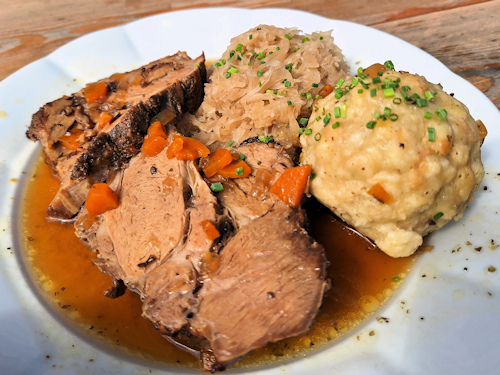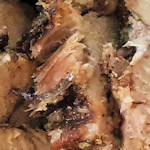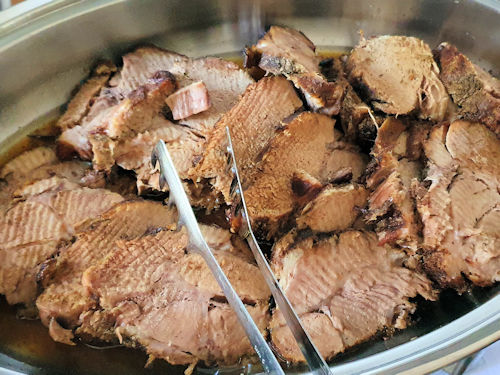No wedding feast or similar is complete in Austria without the obligatory Schweinsbraten: a joint of pork roasted in a shallow broth. And menus in traditional Viennese restaurants almost certainly feature the dish.
- Pork shoulder typically seasoned with caraway and garlic
- Commonly served with bread-based dumplings and sauerkraut
- Still very popular in Viennese households
- Book a concert & dinner* for Vienna
- See also:
What is Schweinsbraten?

(A series of historical images of Viennese workers from 1804-1812 includes this one of a “Bratenbraterin” selling roast meat from her stand; drawn by Georg Emanuel Opitz, engraved by Kilian d. Ä. Ponheimer, and published by Joseph Eder; excerpt reproduced with permission under the terms of the CC0 licence)
Behind Vienna’s imperial grandeur, dulcet musical tones, and contemporary cosmopolitan flair lies an earthy, unrefined, solidly working-class, traditional Viennese soul.
It flairs up occasionally in the older kind of coffee house waiting staff or in the heavily-accented grumblings of a passing senior citizen.
You see it in the stoic, prepared-for-the-worst faces of tram travelers for whom one of the world’s most efficient and inexpensive public transport systems is merely a portent of the imminent end of days.
And it lives, particularly, in the traditional meat dishes that survive every health and culinary fad that strikes the city. Wiener Schnitzel, for example. And the good-old Schweinsbraten: a dish that dates back to the time of the Celts.
Schweinsbraten translates simply as roast pork, which tells you most (but not all) you need to know.

(Schweinsbraten with the most popular side dishes: sauerkraut and dumplings)
At home, we usually use some kind of shoulder joint but, as you might imagine, various recipes exist. The key elements are the seasoning, the roasting environment, and the side dishes.
Seasoning
Before roasting, you season the surface of the meat with caraway, garlic, salt, and pepper (or, if you’re lazy like me, with a pre-bought Schweinsbraten seasoning mix).
The trick is to get a tasty crust to add that little extra to each slice of pork.
Roasting
The joint roasts in around half an inch of liquid, typically a self-made broth or simply water and a soup cube. You top up the broth where necessary and use it to regularly baste the joint.
You also add a few vegetables to the roasting tin: I like to put in blocks of onion, leek, and carrot.
(A common dish at event buffets)
Equally, the vegetables also take in the broth’s flavour in a taste merry-go-round.
During the cooking process, the broth becomes strongly flavoured by the meat and vegetables to give you a gorgeous basis for the sauce or gravy. Most times, you just pour it out of the dish straight into the gravy boater.
Side dishes
Most Austrians serve Schweinsbraten with bread-based Knödel (look for Semmelknödel or Serviettenknödel on that page) and sauerkraut. Those of us who regard the latter as an invention of Satan simply ensure enough vegetables fill the roasting tin to act as a side-dish in their own right.
And any leftover meat leaves you with cold pork slices for eating with beer and bread the next day.
As you can imagine, Schweinsbraten makes an excellent Sunday roast or a meal for special occasions (I’m vegetarian, but do one for my wife’s birthday, for example.). And most traditional Viennese restaurant menus feature the dish.

